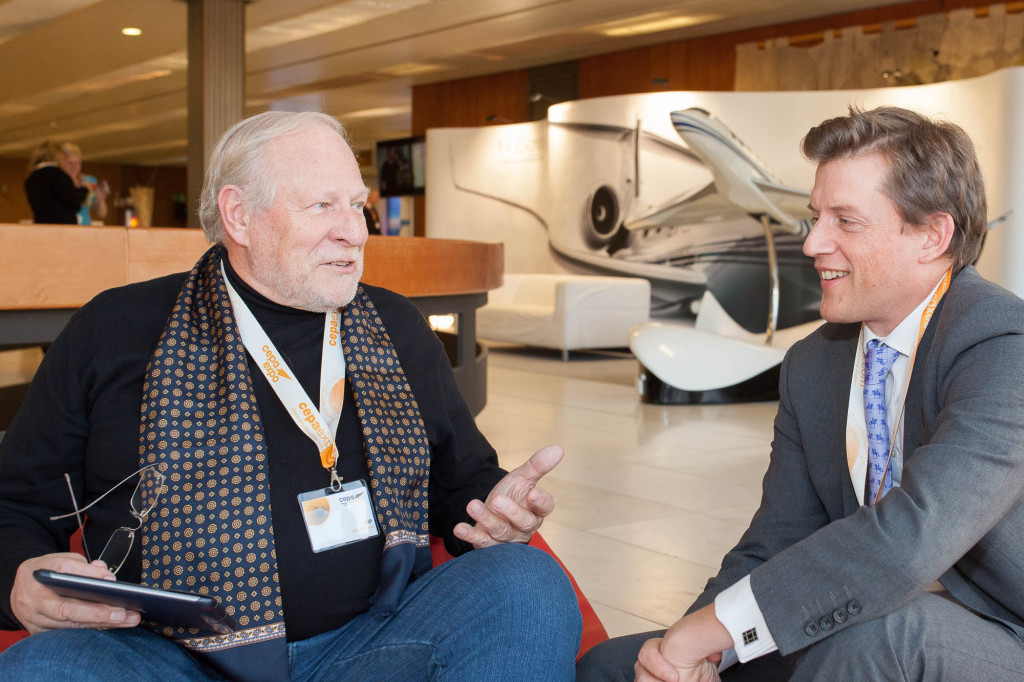Interview: Richard Koe – Intelligence is a Must; not a Myth!
Richard Koe, Managing Director of WINGX Advance was yesterday’s first key note speaker after the conference opening rituals. WINGX Advance specializes on business aviation intelligence gathering and analysis. To have a key note speaker like Richard as a conference opener is important because the presented facts are frequently referred to in many of the following panel discussions. Panels may reflect opinions and experiences; Richard’s expertise is factual and contributes to explaining why things happened and indicate what might be expected in the future. The conference schedule only allowed for a 30-minute presentation but we all know that there is more information and knowledge. I had the opportunity to sit down with him and get a bit more out of him from different angles:
 CdrB: “Business Aviation exists for quite awhile now. Richard, give me some straight answers. To begin with, what should the professionals in the industry keep in mind?”
CdrB: “Business Aviation exists for quite awhile now. Richard, give me some straight answers. To begin with, what should the professionals in the industry keep in mind?”
Richard K: “Business Aviation today in many ways still resembles its origins as a private flight department for very rich people. In some ways, it’s an old fashioned concierge business mostly still run by pilots and aircraft enthusiasts, with its main focus on the aircraft owner, not the charter customer. Its DNA is not commercial as its raison-d´etre has been to provide service at cost, rather than make money or grow. It needs to change if it is to realize its potential to provide a business tool to thousands of travelers who cannot effectively meet their travel needs with the scheduled aviation services.”
CdrB: “Okay. I hear what you’re saying. What I observe is that all the executives and managers in the various parts of the industry have expertise and a long experience. So, there all a bit like “Mr.-Know-It-All”. What do you believe that they need to know more than they already do?”
Richard K: “Yes, business aviation is quite an insulated industry and some of its executives probably don’t think it needs to change. But the fact is, it’s not in great shape. Most of its operators are unprofitable, and aircraft deliveries, prices and flights are in their 5th year of decline. In any other industry, this recession would have been precipitated a major shake-up, with lots of firms going bust, others consolidating and innovating. Instead, by and large the industry has stuck its head in the sand and wants the storm to blow over.”
CdrB: “What is all the intelligence -“hupla” about? One report says that things look rosy in the future; the next carefully states that things are stagnating. And the reader thinks: “Sure, but what’s in it for me?”
Richard K: “In any other industry it goes without saying that you need to know what´s going on in your market. Market activity is the main basis for investment decisions, resource allocation and business development; without it you cannot understand your customer. Business Aviation is no different. Of course to answer your other comment, the analysis has to be of high quality, otherwise it’s simply misleading”
CdrB: “What is essential to know and get straight answers for? Is the confident businessman who serves all needs of his clients better off just moving ahead to the best of his knowledge without the forecasts?”
Richard K: “We do not pretend to provide a crystal ball on the future. Our intelligence exposes the current state and value of the market, and relates these trends to the specific interests of clients. In our view, no business should want to invest in a market where this information is unobtainable, however confident they are about making the right decisions on gut instinct.”
CdrB: “Why is it not enough to just read forecasts and statistics in magazines? Why do you ask for more?”
Richard K: “We agree that professional and clear presentation in trade journals are helpful, which is why we are always willing to contribute facts and statistics. But to make the analysis meaningful, and actionable, we need to explain the implications of our insights
for a business, in terms of risks and opportunities.”
CdrB: “Revenue may be related to traffic, and traffic figures are found in statistics. Statistics are history and the future is only seen in a crystal ball. What can numbers suggest for future traffic and revenues?”
Richard K: “Yes, we’re all weary of economists getting their forecasts wrong but no one seriously believes that the future simply pops into existence without any relation to the present and the past. For example, you can only really project business aviation
activity in 2014 by understanding its trends during this year.”

CdrB: “What do you see happening on the computer screen and systems that are getting too little attention? “
Richard K: “Beyond the computer screen, think smart phone. What is happening, wherever you look in the travel sector, is that customers expect to be able to search,evaluate, compare and purchase services online, on the move, in real time. They expect this of business aviation as well, and because they don´t get it, our market is much smaller and less relevant than it should be.”
CdrB: “If you were on the Board or a Committee of a Business Aviation association, what would you try to accomplish that would be the right thing for the industry?”
Richard K: “Two things in particular. We need to encourage promising initiatives, such as those enhancing the customers’ ability to pick and choose services from a transparent market. And we need to combat negative issues, especially illegal flights, which blight the industry’s reputation.”
CdrB: “Richard, your concluding general remarks?”
Richard K: “This is a very exiting industry to be in because of its growth potential. Business aviation has no choice but to grow up, and when it does, painful though that might be, it will appeal to a much larger market.”
CdrB: “We’ve heard your presentation. Give us a quick short CEE summary.”
Richard K: “Business aviation in this region grew spectacularly until 2008, but has slowed since then and is struggling this year. But the potential is there for more growth, now that the regional economy has stabilized. Ukraine is already showing the way, and the
Czech Republic is also cementing its importance in the region. And there significant pockets of growth in terms of customer demand. For example, activity at the top and bottom end of the jet fleet – on ultra long range jets and very light jets – is 10% up this year on last year. We expect CEPAbusiness aviation activity to resume its growth path from 2014.”
CdrB: “Thanks Richard, for sharing your expertise with us.”
Cdr. Bud Slabbaert
Publishing or copying the content of AVIATION Times without a written electronic permission is strictly forbidden. If you have any information, tips, videos, photos or your press releases for us contact us at news@aviation-times.aero.
AVIATION TIMES © Copyright 2012 - 2025







